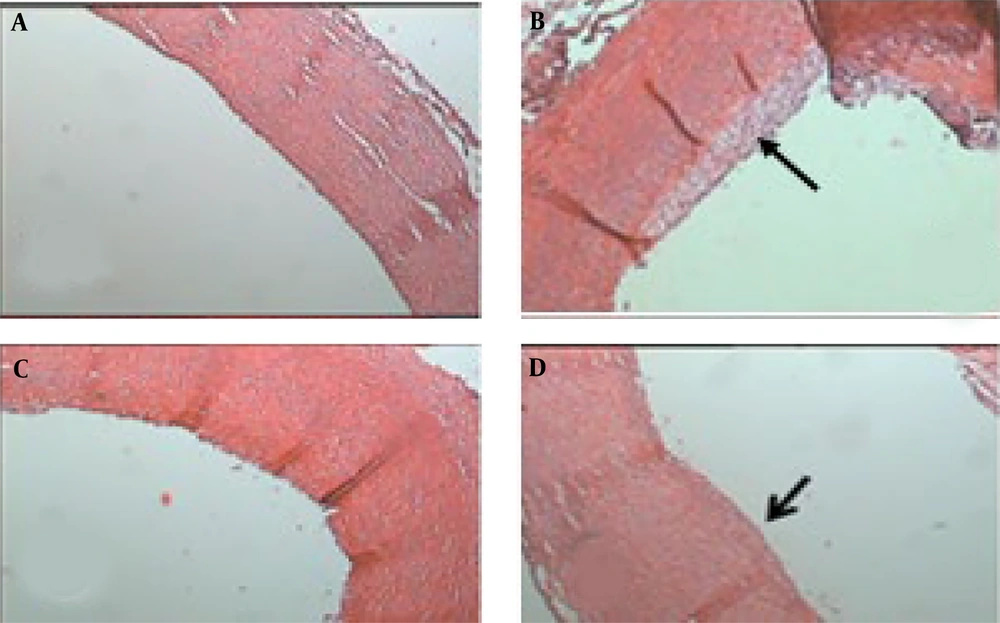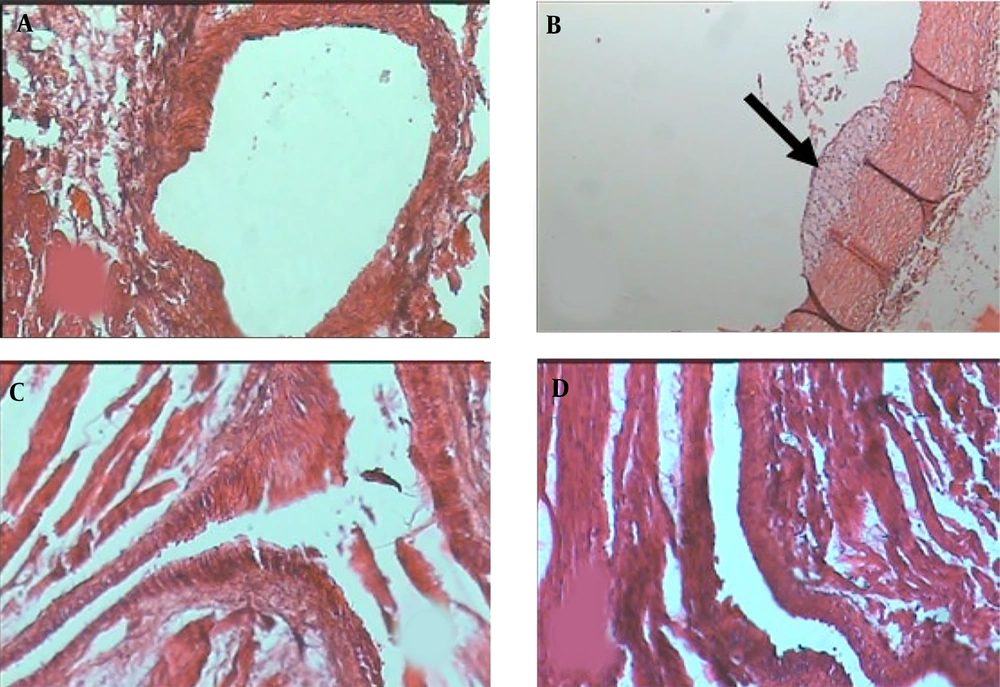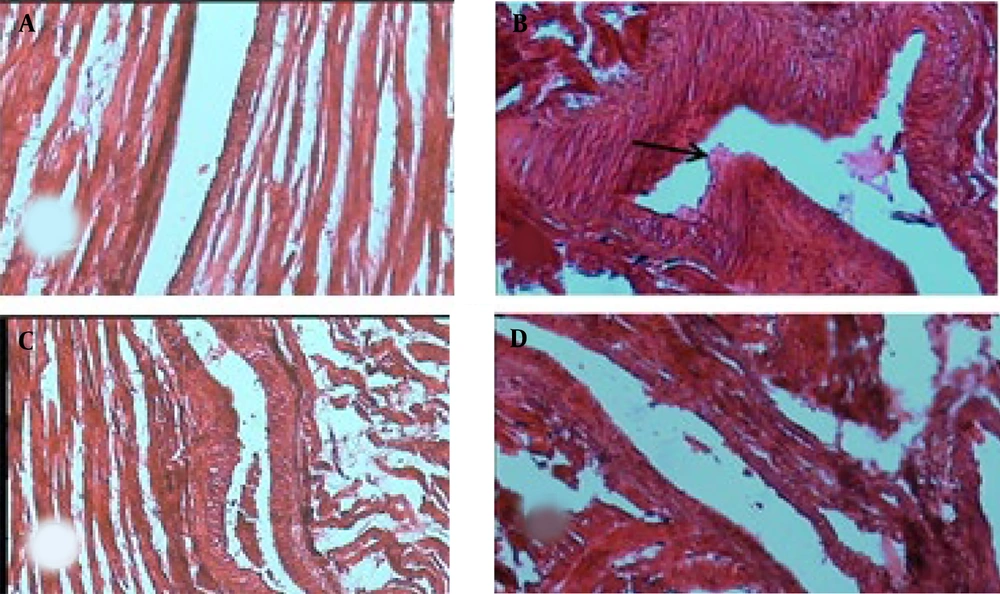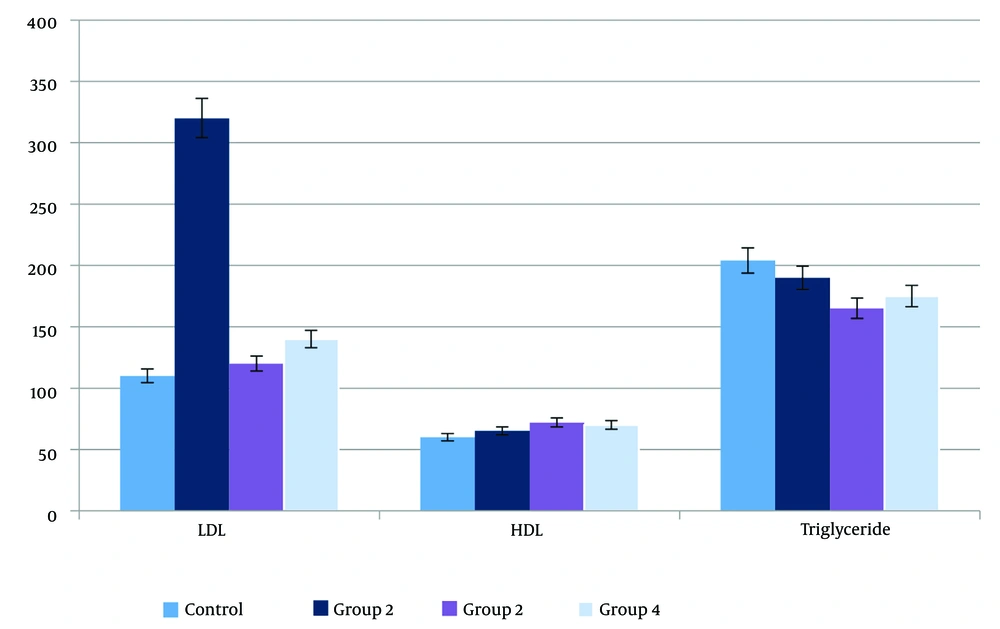1. Background
Lead as a toxic heavy metal is detrimental and an important environmental health hazard worldwide, both in humans and animals of all ages, in particular adolescents (1, 2). Lead acetate can induce atherosclerosis by damaging the endothelial cells and by oxidation of low-density lipoprotein (LDL) (3). The latter increases serum cholesterol levels that in turn trigger the accumulation of fatty streaks which are the first detectable step in atherogenesis in the arteries (4). Therefore, it has been proposed that the prevention of LDL oxidation and decrease of serum cholesterol levels might substantially delay atherosclerosis (5).
It is well-documented that cardiovascular diseases (CVDs) cause mortalities in the world (6). Different environmental risk factors can cause CVDs, and air pollution is considered to be among the important risk factors for CVDs (7). Previous studies have demonstrated that exposure to lead, as the main aspect of air pollution, is associated with different types of CVDs, mainly atherosclerotic CVDs (ASCVDs) and cardiovascular events (8, 9).
Vitamin C is an antioxidant, and kombucha has a high amount of glucuronic acid that can prevent cholesterol accumulation (10, 11). Accordingly, it has been reported that the oral administration of ascorbic acid can result in lead chelation and reduce the risk of heavy metal poisoning. Ascorbic acid also reduces intestinal absorption of lead and increases renal filtration (12). This vitamin is a lactone with an endiola group that can be combined with lead to form a very low ionic but water-soluble compound (13, 14). Therefore, it was presumed that ascorbic acid could be an alternative method for lead poisoning therapy (15). Ascorbic acid, as a well-known chelating agent with antioxidant characteristics and lead-reducing effects, was reported to have the capability to protect cells from the toxic effects of lead (16).
Kombucha is an ancient, about 2000-year-old food and healing substance based upon yeast, sugar, and black tea, which are exposed to fermentation and consist of vitamin C, organic materials, enzymes, lactic acid bacteria, and B-group vitamins (10). It originated in China and then spread to Japan and Russia and later to Europe and the United States because many beneficial effects were attributed to this drink, particularly on lipoproteins (17). Some studies have indicated that kombucha can reduce LDL-cholesterol levels and increase high-density lipoprotein cholesterol (HDL-cholesterol) (10, 18). Some other studies have suggested that the antiatherogenic effect of kombucha might be due to its antioxidant activity (19).
2. Objectives
The aim of this study was to determine the possible beneficial effects of ascorbic acid and kombucha on the endothelium of coronary arteries and aorta in lead-exposed rabbits. This study also compared the effects of kombucha and vitamin C on free-radical and cholesterol levels and, finally, the formation of atherosclerosis plaques in male rabbits on a high-cholesterol diet exposed to lead acetate.
3. Methods
3.1. Animals
Forty male rabbits (New Zealand white, 1.6 - 2 kg, and 5 months old) (14) were obtained from the Pasteur Institute of Iran, and because the rabbits were of the same weight and age, the block randomization method was used for random allocation. However, three of the rabbits in the fourth group died during the test. The rabbits were divided randomly into four groups: Group 1 (n = 10) served as a control group. All procedures performed in studies involving animals were in accordance with the ethical standards of the institutional and national research committee and with the 1964 Helsinki Declaration and its later amendments or comparable ethical standards.
Rabbits in group 2 (n = 10) received water containing 547 ppm lead acetate and a high-cholesterol diet (1% of food weight). Group 3 (n = 10) received water containing 547 ppm lead acetate and a high-cholesterol diet (1% of food weight). With ascorbic acid 500 mg/kg for 40 days. Group 4 (n = 7) received water containing 547 ppm lead acetate and a high-cholesterol diet (1% of food weight). The three rabbits in group 4 died during the test. With kombucha extract (10 mL/kg) daily by oral gavage method for 40 days (20). The study was approved by the Research Ethics Committee of the Maragheh University of Medical Sciences, Maragheh, Iran.
3.2. Longitudinal Scale Micrometer
Real length longitudinal scale micrometer is, as two perpendicular axes to each other, one centimeter. At a magnification of 100 x, the virtual length of each axis is one millimeter, and the virtual length of each of its hundred parts is equal to 10 micrometers. After adjusting the micrometer in the eyepiece position of the light microscope, the size of the plaques and the thickness of the artery wall were measured at 100 x magnification.
3.3. Kombucha Extract Preparation
To prepare the kombucha beverage, the necessary equipment was sterilized for 2 hours at 120°C. After sterilization, one liter of distilled water was spilled into a Pyrex glass container, and 200 g of sugar was added to the solution and boiled for 5 minutes. Then, 3 gr of dry tea was added to the solution, and after preparation, the beaker was placed at room temperature. Then, 100 mL of kombucha was added as a starter material for fermentation. To prevent contamination, the mouth of the jar was tightly closed and was placed away from sunlight for 9 days. Then, the solution was filtered through a clean lace and stored in the refrigerator (21).
3.4. Measurement of Blood Lipids
At the end of the experiment, 10 mL of blood samples were drawn to determine the levels of triglycerides (TG), LDL-cholesterol, and HDL-cholesterol in heparin-sealed plastic tubes, sent immediately to the laboratory, and measured by Method 8003 American National Institute of Occupational Safety and Health (NIOSH) (22).
3.5. Vascular Dissection
After treatment, all the rabbits were anesthetized with 50 mg/kg /5 mg/kg concentration of ketamine/xylazine by an intraperitoneal injection (23). Moreover, the rabbits were sacrificed; the chests and hearts of the rabbits were dissected, and the hearts were placed in physiological serum. The tissue samples were kept in formalin for one week, and tissue processing was performed on the samples. Then, using a microtome, we prepared tissue sections with a thickness of 5 microns from the thoracic aorta and coronary arteries. The sections of vessels were stained by hematoxylin and eosin (H&E) and were examined by light microscopy.
3.6. Measurement of Blood Lipids
At the end of the experiment, a total of 10 mL of blood sample was taken from each animal and sent immediately to the laboratory to determine the levels of TG, LDL-cholesterol, and HDL-cholesterol in heparin-sealed plastic tubes. The serum levels of HDL and TG were determined by a Roche Hitachi (Model 917) using a triglyceride kit (Aria Pharma Kit) and HDL kit (HDL-D PPT Test kit, Coral Clinical Chemistry Test Analyzer). The serum levels of LDL were determined using the kit Rat LDL-Cholesterol Assay Kits provided by Crystal Chem; the kit eliminates all the lipoproteins except for LDL and determines its serum levels by an enzymatic technique (22).
3.7. Histological Analysis
The animals of each group were anesthetized with pentobarbital, and their coronary arteries and aorta were dissected under surgery. Moreover, 10 microscopic sections were taken from each coronary artery and aorta, stained by H&E staining, and then analyzed by light microscopy. The atherosclerotic plaques of vessels were compared in the between groups.
3.8. Statistical Analysis
The data were analyzed with one-way analysis of variance (ANOVA) statistical methods using SPSS software (version 15, Chicago). Data were analyzed with one-way ANOVA statistical methods using SPSS software (version 15, Chicago). In addition, the post hoc test (such as Scheffe) was used to determine which two groups exhibited significant differences. Statistical significance was defined at P < 0.05 (Table 1).
| Dependent Variable | Mean Difference | P-Value | ||
|---|---|---|---|---|
| LDL | 1 | 2 | -157.900 | < 0.001 |
| 3 | 2.600 | > 0.99 | ||
| 4 | 14.843 | > 0.99 | ||
| 2 | 3 | 160.500 | < 0.001 | |
| 4 | 172.743 | < 0.001 | ||
| 3 | 4 | 12.243 | > 0.99 | |
| Triglyceride | 1 | 2 | 11.900 | 0.268 |
| 3 | 16.200 | 0.046 | ||
| 4 | 28.500 | < 0.001 | ||
| 2 | 3 | 4.300 | > 0.99 | |
| 4 | 16.600 | 0.075 | ||
| 3 | 4 | 12.300 | 0.353 | |
The Results of Post Hoc Scheffe Test for the Evaluation of Low-Density Lipoprotein (LDL), High-Density Lipoprotein (HDL), and Triglyceride Serum Levels a
4. Results
No rabbit died during the study. The results of this study showed that the administration of lead acetate in rabbits fed with a cholesterol-rich diet produced deleterious effects on the endothelium of the aorta and coronary arteries, and these effects were relatively improved by the administration of vitamin C, most probably due to its antioxidant properties, but not by kombucha. The light microscopic analysis of the aorta sections (Figure 1A, B, C, D), left coronary artery sections (Figure 2A, B, C, D), and right coronary artery sections (Figure 3A, B, C, D) showed that rabbits which received water containing lead acetate and were fed with high-cholesterol diet (group 2) developed plaques in coronary arteries and aorta. Treatment with vitamin C inhibited plaque formation in both coronary arteries and in the aorta. However, kombucha in us concentrations were able only to prevent the formation of small atherosclerotic plaques in coronary arteries but not the larger plaques in the aorta.
H&E staining of aorta artery. Group 1 received a standard diet (A). Group 2 developed atherosclerotic plaques in the aorta (B). No atherosclerotic plaques were detected in group 3, which received ascorbic acid (C), while in group 4, which was treated with kombucha, large plaques were detected in the aorta (D). Magnification, 40 x.
H&E staining of the left coronary artery. Group 1 received a standard diet (A). Group 2 developed atherosclerotic plaques in the arteries (B). No development of large atherosclerotic plaques was observed in groups 3 (C) and 4 (D), which were treated with ascorbic acid and kombucha, respectively. Magnification, 40 x.
The microscopic section of the coronary artery of group 2 with a magnification of 40 x had a grade 3 lesion, and in the aorta artery of group 2 with a magnification of 40 x had a grade 3 lesion (Figure 1B). However, grade 1 lesions were observed in group D, which received kombucha (Figure 1D). Moreover, no lesions were observed in group C, which received vitamin C (Figure 1C).
The results of the Scheffe test showed significant differences in LDL serum levels between groups 1 and 2 and between groups 3 and 4. In other words, the mean serum levels of LDL in the group that received lead acetate and a high-cholesterol diet were higher than those in the control group. Additionally, the results of the Scheffe test showed significant differences in TG serum levels between groups 1 and 4 (Table 1) (24).
Although vitamin C was successful in preventing the development of atherosclerotic plaques in both coronary arteries and aorta and treatment with kombucha prevented only the development of large atherosclerotic plaques in the aorta, neither of these substances had any significant effect on HDL-cholesterol, LDL-cholesterol, and TG. There was no significant difference between the effects of ascorbic acid and kombucha on HDL-cholesterol; however, LDL-cholesterol and TG levels were higher in rabbits treated with kombucha than in those treated with vitamin C (Figure 4).
Plasma levels of triglycerides, LDL, and HDL (mg/dL). Values are mean ± SEM for 8 rabbits per group after treatment. Statistical analyses indicated differences between groups for any lipoprotein fraction after treatment. In group 2, due to the consumption of cholesterol and the effect of lead, the level of LDL was higher; however, in the other groups, due to the consumption of vitamin C and kombucha, the level of LDL was low. There was no significant difference in the amount of HDL and triglycerides in the groups. There was only a significant difference between group 2 and group 4,3 in LDL-cholesterol and triglycerides (P < 0.001).
5. Discussion
Complex interactions exist between the function of endothelial cells and smooth muscles in the arterial wall and the nervous system. Toxic metals similar to cadmium, arsenic, and lead can target the vascular system through different pathways (25). The exposure of vascular endothelial cells to any toxic metal(s), including lead circulating in the blood, will have harmful effects on their function (25). Atherosclerosis is a process in which LDL-cholesterol is accumulated in the intima of the arteries after endothelial dysfunction or damage. The increased serum levels of LDL-cholesterol and oxidation of lipoproteins have an important role in atherogenesis. Therefore, it has been proposed that the prevention of oxidation of LDL particles and decreasing the levels of LDL-cholesterol can prevent atherosclerosis (26).
It has been shown that lead acetate causes histological lesions in the endothelium, causing the accumulation of LDL particles and the formation of fatty streaks in the arteries (10, 27). Fatty streaks are the first step in atherogenesis that can be detected macroscopically. The results of morphological analysis in this study showed the formation of atherosclerotic plaques in the aorta and coronary arteries of the animals who received lead acetate and were fed with a cholesterol-rich diet; however, no lesions of endothelial cells were observed in the control group and animals who were treated with antioxidant vitamin C although they have received lead acetate. However, significant atherosclerotic plaques were observed in the inner layer of the aortas in the group of animals treated with kombucha who received lead acetate. The aforementioned results suggest that kombucha cannot prevent the formation of large plaques in animals treated with lead acetate; nevertheless, it might be effective in preventing the formation of small plaques in the coronary arteries.
It could be speculated that the prevention of atherosclerosis with a high dosage of kombucha during a long-term period might be effective. However, compared to kombucha, treatment with vitamin C prevented the formation of atherosclerotic plaques both in the aorta and coronary. It seems that the scavenging effects on free radicals by vitamin C and kombucha are different. The superoxide anion scavenging ratio of vitamin C is higher than kombucha (28). Moreover, vitamin C has a chelating capacity for lead, quenches the reactive oxygen species, and shows preventive effects against lead toxicity (5, 9, 29, 30). However, some studies have not confirmed this issue (31).
Vitamin C can also prevent LDL particle oxidation and peroxidation of membrane lipids and, therefore, prevent endothelial cell damage (32). The oxidation of LDL particles by free radicals can cause damage to artery walls and precipitate the development of atherosclerosis. Vitamin C protects the arterial wall cells and cardiovascular system by facilitating fat metabolism (33). Nevertheless, some studies have shown that the combination of vitamin C and E cannot completely eliminate atherosclerosis in rabbit aorta and does not significantly inhibit atherosclerosis (24, 34). Vitamin C inhibits the expression of inducible nitric oxide synthases (iNOS) in endothelial cells and neuronal nitric oxide synthase (nNOS) and thereby reduces the level of NO in plasma, which is responsible for the guanylate cyclase activation, which counteracts the effects of vasoconstrictors.
Vitamin C scavenges the Pb2+-generated reactive oxygen species (ROS). There are several pieces of evidence representing vitamin C's anti-inflammatory effects by inhibiting the nuclear factor kappa (NF-kB), tumor necrosis factor-alpha (TNF-α), (IL-1), and interleukin-6 (IL-6). Increased dietary intake of vitamin C significantly decreases the serum cholesterol values. Dietary vitamin C stimulates the synthesis of cholesterol and increases the turnover rate of the cholesterol body pool (35). It has an important role in the generation of connective tissue and protection against the development and progression of atherosclerosis (36). Vitamin C deficiency increases the risk of arterial hypertension and myocardial infarction (37).
According to Adriani et al.’s study (10), kombucha can decrease cholesterol levels by inhibiting the activity of the 3-hydroxy 3-methylglutaryl coenzyme A (CoA) reductase enzyme. In this study, the animals treated with kombucha had higher values of LDL-cholesterol and TG, which might contribute to the formation of atherosclerotic lesions in the aortas, which was not the case with the animals treated with vitamin C. In this study, the effects of ascorbic acid and kombucha were compared concerning not only their effects on serum lipoproteins but also on the development of atherosclerosis. This study showed that ascorbic acid can protect the endothelial cells of the arteries, which kombucha could not, and this effect of vitamin C is most probably due to a higher scavenger ability.
This study has some limitations. The most important one is the relatively small number of animals in each tested group. Therefore, it would be necessary to conduct a study on a higher number of animals to confirm the results of the present study.
5.1. Conclusions
The results of this study showed that administration of lead acetate in rabbits fed with a cholesterol diet produced deleterious effects on the endothelium of the aorta and coronary arteries. These effects were relatively improved by the administration of vitamin C but not with kombucha. According to the results of this study, it can be concluded that vitamin C improves endothelial dysfunction and prevents the formation of atherosclerosis plaques in the aorta and coronary arteries. However, kombucha was not able to prevent the formation of large plaques in the inner layer of the aorta, although it seems that it had some effects on preventing atherosclerotic lesions in the coronary arteries.
The difference in LDL levels between groups 3 and 4 was less; therefore, kombucha cannot completely reduce the level of LDL, cholesterol, and plaques during this treatment period, compared to vitamin C. Therefore, more time is needed for treatment with kombucha, which is the reason for the difference between kombucha and vitamin C in preventing the formation of plaque in the aorta. One of the reasons for this difference might also be the fact that animals treated with kombucha had higher levels of LDL-cholesterol and TG than the animals treated with vitamin C. One might speculate that higher doses of kombucha and a longer treatment period might have positive effects on large atherosclerotic plaque formation; however, this study could not prove any beneficial effects of kombucha on large atherosclerotic plaques in the aortas.



